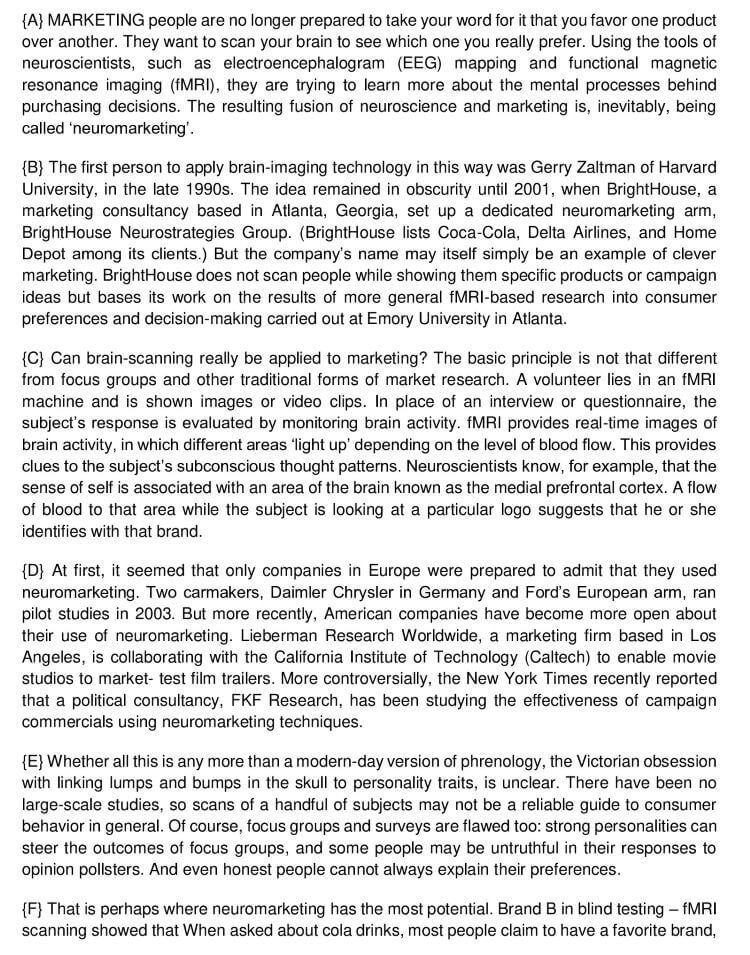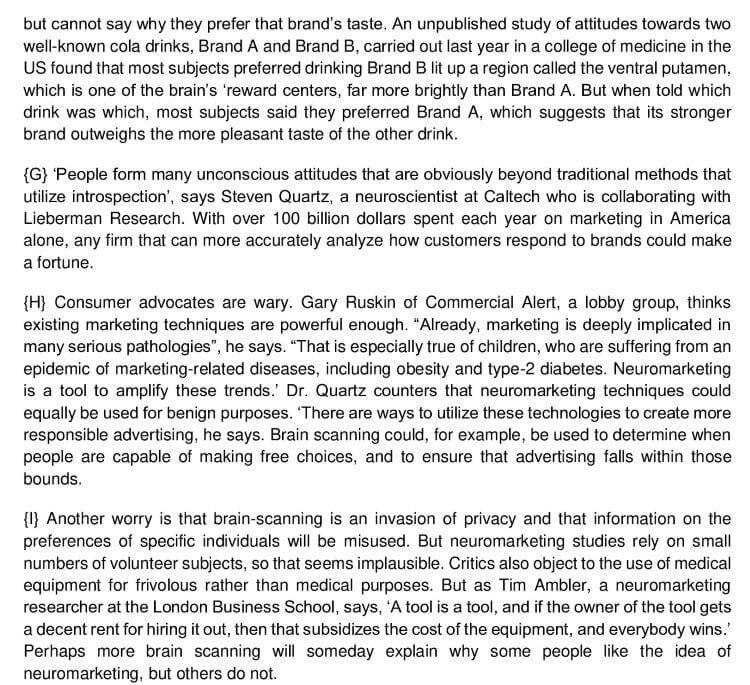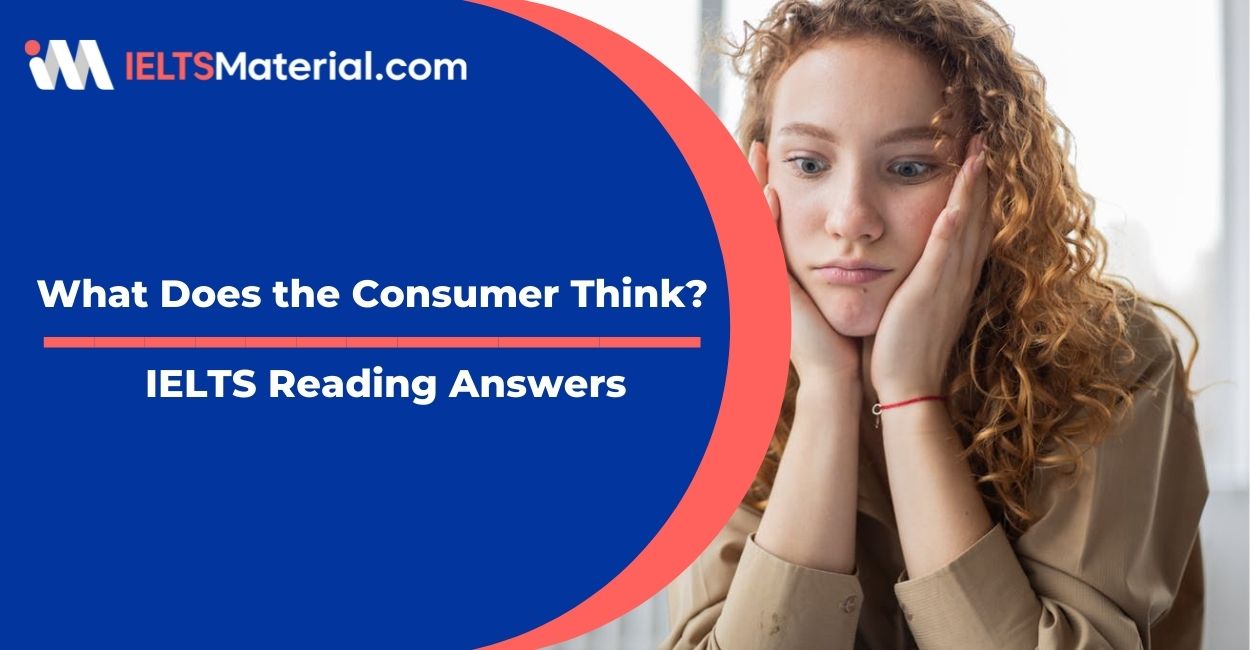What Does the Consumer Think?- IELTS Reading Answers
8 min read
Updated On
-
Copy link
Table of Contents

Limited-Time Offer : Access a FREE 10-Day IELTS Study Plan!
Reading Passage
What Does the Consumer Think?


Questions 14-19
Reading Passage 2 has ten paragraphs A-J.
Choose the correct heading for Paragraphs B-G from the list of headings below. Write the correct number (i-x) in boxes 14-19 on your answer sheet.
| List of Heading
(i) A description of the procedure and mechanism (ii) An international research project (iii) An experiment to investigate consumer responses (Iv) Marketing with an alternative name (V) A misleading name for a business? (Vi) A potentially profitable line of research (Vii) Medical dangers of the technique (Viii) Internal drawbacks to marketing tools (Ix) Broadening applications (X) What is neuromarketing? |
Example
Paragraph A x
14 Paragraph B
15 Paragraph C
16 Paragraph D
17 Paragraph E
18 Paragraph F
19 Paragraph G
Questions 20-22
Look at the following people (Questions 20-22) and the list of opinions below. Match each person with the opinion credited to him.
Write the correct letter A-F in boxes 20-22 on your answer sheet.
20 Steven Quartz
21 Gary Ruskin
22 Tim Ambler
| List of opinions
(A) Neuromarketing could be used to contribute towards the cost of medical technology (B) Neuromarketing could use introspection as a tool in marketing research. (C) Neuromarketing could be a means of treating medical problems. (D) Neuromarketing could make an existing problem worse. (E) Neuromarketing could lead to the misuse of medical equipment. (F) Neuromarketing could be used to prevent the exploitation of consumers |
Questions 23-26
Complete the summary below using words from the passage.
Choose ONE WORD ONLY from the passage for each answer.
Write your answers in boxes 23-26 on your answer sheet.
| Neuromarketing can provide valuable information on attitudes to particular 23..……………….. It may be more reliable than surveys, where people can be 24 …………., or focus groups, where they may be influenced by others. It also allows researchers to identify the subject’s 25………………..thought patterns. However, some people are concerned that it could lead to problems such as an increase in disease among 26 …………. |
Reading Answers
14 Answer: Ⅴ
Question type: Match headings
Answer location: Paragraph B, lines 2-8
Answer explanation: “The idea remained in obscurity until 2001, when BrightHouse, a marketing consultancy based in Atlanta, Georgia, set up a dedicated neuromarketing arm, BrightHouse Neurostrategies Group. (BrightHouse lists Coca-Cola, Delta Airlines, and Home Depot among its clients.) But the company’s name may itself simply be an example of clever marketing. BrightHouse does not scan people while showing them specific products or campaign ideas but bases its work on the results of more general fMRI-based research into consumer preferences and decision-making carried out at Emory University in Atlanta.” This is suggestive of a misleading name and was a clever strategy on the part of the Brighthousegroup.
15 Answer: Ⅰ
Question type: Match headings
Answer location: Paragraph C, lines 2-6
Answer explanation: “A volunteer lies in an fMRI machine and is shown images or video clips. In place of an interview or questionnaire, the subject’s response is evaluated by monitoring brain activity. fMRI provides real-time images of brain activity, in which different areas ‘light up’ depending on the level of blood flow. This provides clues to the subject’s subconscious thought patterns.” These lines imply the principles and description of how the fMRI works and how marketers leverage this technique to gain a consumer perspective.
16 Answer: ⅸ
Question type: Match headings
Answer location: Paragraph D, lines 1-6
Answer explanation: “At first, it seemed that only companies in Europe were prepared to admit that they used neuromarketing. Two carmakers, Daimler Chrysler in Germany and Ford’s European arm, ran pilot studies in 2003. But more recently, American companies have become more open about their use of neuromarketing. Lieberman Research Worldwide, a marketing firm based in Los Angeles, is collaborating with the California Institute of Technology (Caltech) to enable movie studios to market- test film trailers.” These lines deliver the broadening scope and wider application of neuromarketing across the world and how more and more companies are putting it into applications.
17 Answer: Ⅷ
Question type: Match headings
Answer location: Paragraph E, lines 1-4
Answer explanation: “Whether all this is any more than a modern-day version of phrenology, the Victorian obsession with linking lumps and bumps in the skull to personality traits, is unclear. There have been no large-scale studies, so scans of a handful of subjects may not be a reliable guide to consumer behavior in general.” These lines highlight the flaws and shortcomings of the neuromarketing techniques owing to various reasons such as having doubts about its competence and efficiency on a large scale, etc.
18 Answer: Ⅲ
Question type: Match headings
Answer location: Paragraph F, lines 3-8
Answer explanation: “ An unpublished study of attitudes towards two well-known cola drinks, Brand A and Brand B, carried out last year in a college of medicine in the US found that most subjects preferred drinking Brand B lit up a region called the ventral putamen, which is one of the brain’s ‘reward centers, far more brightly than Brand A. But when told which drink was which, most subjects said they preferred Brand A, which suggests that its stronger brand outweighs the more pleasant taste of the other drink.” This clearly shows the investigation that was carried out to analyze the brains of the subjects while making decisions and preferring an option over the other one.
19 Answer: Ⅵ
Question type: Match headings
Answer location: Paragraph G, lines 3-5
Answer explanation: “With over 100 billion dollars spent each year on marketing in America alone, any firm that can more accurately analyze how customers respond to brands could make a fortune.” These lines illustrate the essence of the research as far as evaluating the consumers’ responses and behavioral association with a brand is concerned. As per these lines, a business can immensely profit from such research.
20 Answer: F
Question type: Match features
Answer location: Paragraph H, lines 5-9
Answer explanation: “‘There are ways to utilize these technologies to create more responsible advertising, he says. Brain-scanning could, for example, be used to determine when people are capable of making free choices, to ensure that advertising falls within those bounds.” These lines suggest that the neuromarketing techniques could be harnessed to create responsible and considerate advertising that prevents the exploitation of the consumers.
21 Answer: D
Question type: Match features
Answer location: Paragraph H, lines 1-5
Answer explanation: The lines, “ Consumer advocates are wary. Gary Ruskin of Commercial Alert, a lobby group, thinks existing marketing techniques are powerful enough. “Already, marketing is deeply implicated in many serious pathologies”, he says. “That is especially true of children, who are suffering from an epidemic of marketing-related diseases, including obesity and type-2 diabetes. Neuromarketing is a tool to amplify these trends.’”, clearly suggest that neuromarketing according to Ruskin could aggravate the problems and loss that are caused by marketing including persuading the gullible minds and worsening the sickness caused by unhealthy habits that are driven by marketing.
22 Answer: A
Question type: Match features
Answer location: Paragraph I, lines 4-7
Answer explanation: “But as Tim Ambler, a neuromarketing researcher at the London Business School, says, ‘A tool is a tool, and if the owner of the tool gets a decent rent for hiring it out, then that subsidizes the cost of the equipment, and everybody wins.’” These lines suggest that the usage and application of neuromarketing could help in getting the cost of upkeep of such expensive equipment that is used in the neuroscience and medical field by renting the equipment to marketers and hence, getting it subsidized.
23 Answer: BRANDS(S) / LOGO
Question type: Summary completion
Answer location: Paragraph C, last lines
Answer explanation: “A flow of blood to that area while the subject is looking at a particular logo suggests that he or she identifies with that brand.” This suggests that neuroscience in marketing could help the brands to know about the behavior and reaction of consumers towards their brands.
24 Answer: UNTRUTHFUL
Question type: Summary completion
Answer location: Paragraph E, lines 4-6
Answer explanation: “ Of course, focus groups and surveys are flawed too: strong personalities can steer the outcomes of focus groups, and some people may be untruthful in their responses to opinion pollsters.” These lines suggest that the results of such surveys and poles could be deceptive and untrustworthy as some people might respond in an untruthful way. Hence, the results of surveys can’t always be blindly trusted.
25 Answer: UNCONSCIOUS / SUBCONSCIOUS
Question type: Summary completion
Answer location: Paragraph G, lines 1-3
Answer explanation: “‘People form many unconscious attitudes that are obviously beyond traditional methods that utilize introspection’, says Steven Quartz, a neuroscientist at Caltech who is collaborating with Lieberman Research.” These lines suggest that neuromarketing could help businesses know the complex behaviors of people that are summed up as a result of complicated introspection and unconscious attitudes people.
26 Answer: CHILDREN
Question type: Summary completion
Answer location: Paragraph H, lines 1-5
Answer explanation: The lines, “ Consumer advocates are wary. Gary Ruskin of Commercial Alert, a lobby group, thinks existing marketing techniques are powerful enough. “Already, marketing is deeply implicated in many serious pathologies”, he says. “That is especially true of children, who are suffering from an epidemic of marketing-related diseases, including obesity and type-2 diabetes. Neuromarketing is a tool to amplify these trends.’”, clearly suggest that neuromarketing according to Ruskin could aggravate the problems and loss that are caused by marketing, especially among children. Children are most prone to be brainwashed and entranced by the marketing gimmicks, which over the years have caused many health-related problems in children.
Check More IELTS Reading Answers
Practice IELTS Reading based on question types

Start Preparing for IELTS: Get Your 10-Day Study Plan Today!
Recent Articles

Nehasri Ravishenbagam

Haniya Yashfeen

Haniya Yashfeen

Haniya Yashfeen




Post your Comments